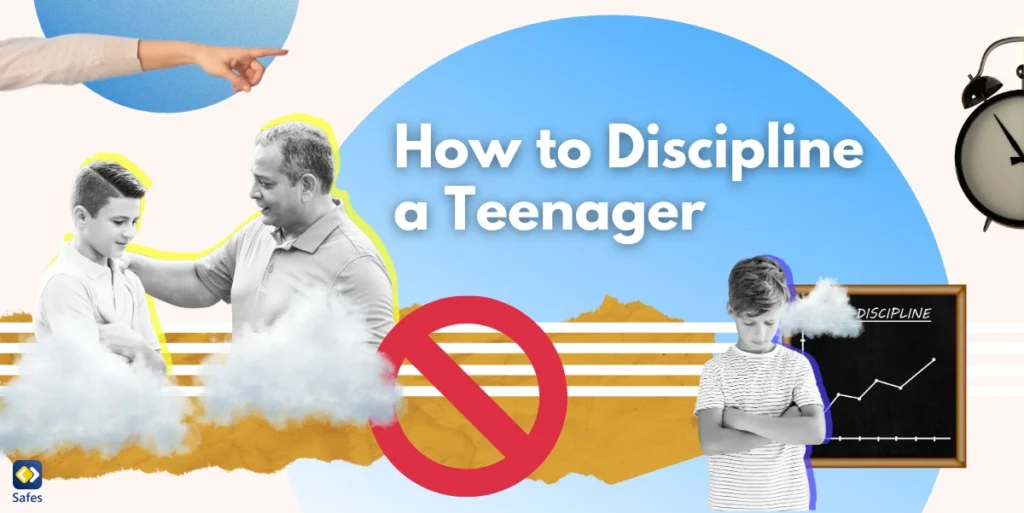Parenting a teenager can feel like navigating a minefield. One moment, they’re sweet and cooperative, and the next, they’re slamming doors and rolling their eyes. As parents, it’s natural to feel frustrated, overwhelmed, and even helpless when it comes to disciplining your teen. But discipline doesn’t have to mean punishment or conflict. With the right strategies, you can guide your teenager toward responsible behavior while maintaining a strong, trusting relationship.
Download and Start Your Free Trial of the Safes Parental Control App
In this blog post, we’ll explore practical tips for disciplining a teenager, the importance of setting boundaries, and how tools can support you in creating a safe and balanced environment for your teen.
Why Discipline Matters During the Teen Years
Discipline is often misunderstood as simply punishing bad behavior. However, at its core, discipline management is about teaching and guiding. During the teenage years, your child is undergoing significant physical, emotional, and social changes. They’re seeking independence, testing boundaries, and figuring out who they are.
Effective discipline helps teens:
- Develop self-control and responsibility
- Understand the consequences of their actions
- Build problem-solving and decision-making skills
- Feel secure within clear boundaries
The goal isn’t to control your teen but to empower them to make good choices, even when you’re not around. If you’re looking for alternatives to physical punishment, check out this guide on how to discipline a child without hitting.
Challenges of Disciplining a Teenager
Let’s face it: disciplining a teenager isn’t easy. Here are some common challenges parents face:
- Pushback Against Authority: Teens are naturally inclined to question rules and authority figures, including their parents.
- Emotional Volatility: Hormonal changes can make teens moody, irritable, and prone to overreacting.
- Peer Influence: Friends and social media can have a significant impact on your teen’s behavior and decisions.
- Balancing Freedom and Control: Teens crave independence, but they still need guidance and boundaries.
Understanding these challenges can help you approach discipline with empathy and patience. If your teen is particularly resistant, this article on how to discipline a child that won’t listen offers practical tips.

Effective Strategies for Disciplining a Teenager
Here are some proven strategies to help you discipline your teenager effectively:
1. Set Clear Expectations and Boundaries
Teens need to know what’s expected of them. Sit down with your teen and discuss household rules, such as curfews, screen time limits, and responsibilities. Be clear about the consequences of breaking these rules. For a detailed breakdown of age-appropriate strategies, refer to this helpful age-appropriate discipline chart.
If your teen misses curfew, they might lose driving privileges for a week. Consistency is key—enforce the rules every time to avoid confusion. Time-outs can still be effective for teens; learn more about understanding time-outs as a discipline tool.
2. Use Natural Consequences
Whenever possible, let your teen experience the natural consequences of their actions. For instance, if they forget to do their homework, they’ll face the consequences at school. This helps them learn accountability without you having to step in.
3. Stay Calm and Avoid Power Struggles
Teens know how to push your buttons, but losing your temper will only escalate the situation. Instead, stay calm and composed. If you feel yourself getting angry, take a few deep breaths or step away for a moment.
4. Listen and Validate Their Feelings
Teens are more likely to cooperate if they feel heard and understood. When your teen is upset, listen without interrupting. Validate their feelings by saying things like, “I understand why you’re frustrated,” even if you don’t agree with their behavior.
5. Encourage Problem-Solving
Instead of imposing solutions, involve your teen in finding ways to address the issue. For example, if they’re struggling with time management, ask, “What do you think would help you stay on top of your assignments?” This fosters critical thinking and ownership.
6. Praise Positive Behavior
Don’t just focus on the negatives. When your teen makes good choices, acknowledge and praise them. Positive reinforcement can motivate them to continue behaving responsibly. For inspiration, explore these positive discipline examples that focus on encouragement and growth.
7. Be a Role Model
Your actions speak louder than words. Model the behavior you want to see in your teen, whether it’s kindness, honesty, or self-discipline.
The Role of Technology in Teen Discipline
In today’s digital age, technology plays a significant role in teen behavior. From social media to online gaming, teens are constantly connected, which can lead to issues like screen addiction, cyberbullying, and exposure to inappropriate content.
As a parent, it’s important to set boundaries around technology use. But constantly monitoring your teen’s online activity can feel overwhelming. That’s where Safes Family, a parental control app, comes in.
How Safes Family Can Help
Safes Family is a powerful tool designed to help parents create a safe and balanced digital environment for their teens. Here’s how it can support your discipline efforts:
- Screen Time Management: Set daily limits on your teen’s device usage to encourage healthy habits.
- Content Filtering: Block inappropriate websites and apps to protect your teen from harmful content.
- Location Tracking: Keep tabs on your teen’s whereabouts for added peace of mind.
- App Monitoring: See which apps your teen is using and for how long.
- Scheduling: Set device-free times, such as during homework or family meals.
By using Safes Family, you can enforce boundaries without constant nagging or conflict. It’s a practical way to guide your teen toward responsible technology use while respecting their growing independence.
Building a Strong Parent-Teen Relationship
Discipline is most effective when it’s rooted in a strong, trusting relationship. Here are some tips for fostering a positive connection with your teen:
- Spend Quality Time Together: Whether it’s watching a movie, going for a walk, or cooking a meal, make time to bond with your teen.
- Show Interest in Their Lives: Ask about their friends, hobbies, and interests. Let them know you care about what matters to them. Gentle discipline techniques can help maintain a strong bond with your teen; learn more about gentle discipline.
- Be Supportive, Not Critical: Offer encouragement and support, even when your teen makes mistakes.
- Respect Their Privacy: While it’s important to monitor their behavior, avoid invading their privacy unnecessarily.
Pitfalls to Avoid
Disciplining teenagers is a delicate balancing act that requires patience, understanding, and consistency. While it’s natural for parents to want to guide their teens toward responsible behavior, certain pitfalls can undermine these efforts and even harm the parent-teen relationship. Here are four key mistakes parents should avoid when disciplining their teens:
1. Overreacting or Losing Control
One of the most common pitfalls is reacting emotionally or losing control during conflicts. Teens are known for pushing boundaries and testing limits, which can easily trigger frustration or anger in parents. However, responding with yelling, harsh punishments, or ultimatums often escalates the situation and damages trust. Instead of fostering respect, overreacting can lead to resentment and rebellion. Parents should strive to remain calm and composed, even when their teen’s behavior is challenging. Taking a moment to breathe and collect your thoughts before responding can help you address the issue more effectively and model self-regulation for your teen.
2. Being Inconsistent with Rules and Consequences
Inconsistency is another major pitfall that can confuse teens and weaken the effectiveness of discipline. If rules and consequences are enforced sporadically, teens may not take them seriously or may feel that the boundaries are arbitrary. For example, if a teen breaks curfew one night and faces no consequences, but is grounded the next time, they’re likely to become frustrated and less cooperative. Consistency is key to helping teens understand the connection between their actions and the outcomes. Parents should clearly communicate expectations and follow through with consequences every time, ensuring that discipline is fair and predictable.
3. Focusing Only on Punishment
Discipline is often misunderstood as being solely about punishment, but this approach can backfire with teens. Punitive measures, such as taking away privileges or grounding, may stop unwanted behavior in the short term, but they don’t teach teens how to make better choices in the future. Over-relying on punishment can also strain the parent-teen relationship, making teens feel misunderstood or unfairly treated. Instead, parents should focus on teaching and guiding their teens. This might involve discussing the impact of their actions, helping them problem-solve, or encouraging them to reflect on their behavior. Positive reinforcement for good behavior can also be more effective than constant punishment.
4. Ignoring the Importance of Communication and Connection
Finally, one of the biggest pitfalls is neglecting the importance of open communication and a strong emotional connection. Teens are more likely to respond positively to discipline when they feel heard, respected, and valued. If parents adopt an authoritarian approach—dictating rules without explanation or discussion—teens may feel controlled and become defensive. Instead, parents should strive to maintain open lines of communication, listening to their teen’s perspective and validating their feelings, even when they disagree. Building a strong relationship based on trust and mutual respect makes it easier to enforce boundaries and guide teens toward responsible behavior.
By avoiding these pitfalls, parents can create a more positive and effective approach to disciplining their teens. The goal is not to control or punish but to teach, guide, and support teens as they navigate the challenges of adolescence. With patience, consistency, and empathy, parents can help their teens develop the skills and values they need to thrive.
Conclusion
Disciplining a teenager is no easy task, but it’s one of the most important roles you’ll play as a parent. By setting clear boundaries, using effective strategies, and leveraging tools, you can guide your teen toward responsible behavior while maintaining a strong, loving relationship.
Remember, the goal isn’t to control your teen but to equip them with the skills and values they need to thrive in the real world. Teaching your teen self-discipline is a lifelong skill; check out these self-discipline examples for ideas. With patience, consistency, and a little help from technology, you can navigate the challenges of parenting a teenager with confidence. Ready to create a safe and balanced digital environment for your teen? Download Safes Family and use its free trial today on iOS and Android and take the first step toward effective, stress-free discipline.
By following these tips and using the right tools, you can turn the challenges of parenting a teenager into opportunities for growth and connection. Happy parenting!
Your Child’s Online Safety Starts Here
Every parent today needs a solution to manage screen time and keep their child safe online.
Without the right tools, digital risks and excessive screen time can impact children's well-being. Safes helps parents set healthy boundaries, monitor activity, and protect kids from online dangers—all with an easy-to-use app.
Take control of your child’s digital world. Learn more about Safes or download the app to start your free trial today!




